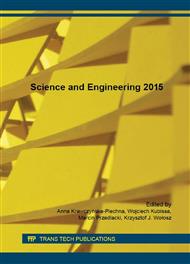[1]
R. Kasprzykowska, A.S. Kołodziejczyk, K. Stachowiak, E. Jankowska, Preparatyka i analiza związków naturalnych, Wydawnictwo Uniwersytetu Gdańskiego, Gdańsk (2009).
Google Scholar
[2]
A. Szczepanik, A. Sobkowiak, Utlenianie limonenu tlenem cząsteczkowym i nadtlenkiem wodoru, Wiadomości Chemiczne 63 (2009) 601-634.
Google Scholar
[3]
M. Trytek, R. Paduch, J. Fiedurek, M. Kandefer-Szerszeń., Monoterpeny - stare związki, nowe zastosowania i biotechnologiczne metody ich otrzymywania, Biotechnologia, 76 (2007) 135-155.
Google Scholar
[4]
J. Sun, D-Limonene – Safety and clinical applications, Alternative Medicine Review 12 (2007) 259-264.
Google Scholar
[5]
G. Coates, C. Byrne, S. Allen, E. Lobkovsky , Alternating copolymerization of limonene oxide and carbon dioxide, J. Am. Chem. Soc. 126 (2004) 11404-11405.
DOI: 10.1021/ja0472580
Google Scholar
[6]
P.A. Wilborn, F. Chu, C. Tang, Progress in renewable polymers from natural terpenes, terpenoids and rosin, Macromol. Rapid Commun. 34 (2013) 8–37.
DOI: 10.1002/marc.201200513
Google Scholar
[7]
M.F.T. Gomes, O.A.C. Antunes, Autoxidation of limonene, α-pinene and β-pinene by dioxygen catalyzed by Co(OAc)2/bromide J. Mol. Catal. 121 (1997) 145-155.
DOI: 10.1016/s1381-1169(97)00010-1
Google Scholar
[8]
J.A. Caram, M.E. Martins, E.G. Gros, C.M. Marschoff, Anodic oxidation of limonene in Br- containing methanolic solutions, Electrochim. Acta 35 (1990) 1163-1165.
DOI: 10.1016/0013-4686(90)80033-k
Google Scholar
[9]
J. S. Beck, J. C. Vartuli, W. J. Roth, M. E. Leonowicz, C. T. Kresge, K. D. Schmitt, C. T. W. Chu, D. H. Olson, E. W. Sheppard, A new family of mesoporous molecular sieves prepared with liquid crystal templates, J. Am. Chem. Soc. 114 (1992).
DOI: 10.1021/ja00053a020
Google Scholar
[10]
C.T. Kresge, M. E. Leonowicz, W. J. Roth, J.C. Vartuli, J.S. Beck, Ordered mesoporous molecular sieves synthesized by a liquid crystal template mechanism, Nature 359 (1992) 710-712.
DOI: 10.1038/359710a0
Google Scholar
[11]
A. Wróblewska, E. Milchert, Charakterystyka katalizatorów tytanowo-silikalitowych, Przem. Chem. 10 (2005) 723.
Google Scholar
[12]
M.V. Cagnoli, S.G. Casucelli, A.M. Alvarez, J.F. Bengoa, N.G. Gallegos, N.M. Samaniego, M.E. Crivello, G.E. Ghione, C.F. Perez, E.R. Herrero, S.G. Marchetti, Clean, limonene epoxidation using Ti-MCM-41 catalyst , Applied Catal. 287 (2005).
DOI: 10.1016/j.apcata.2005.04.001
Google Scholar
[13]
A. Corma, M.T. Navarro, J. Perez Pariente, Synthesis of an ultralarge pore titanium silicate isomorphous to MCM-41 and its application as a catalyst for selective oxidation of hydrocarbons, J. Chem. Soc. Chem. Commun (1994) 147-148.
DOI: 10.1039/c39940000147
Google Scholar
[14]
C. Berlini, M. Guidotti, G. Moretti, R. Psaro, N. Ravasio, Catalytic epoxidation of unsaturated alcohols on Ti-MCM-41, Catal. Today 60 (2000) 219-225.
DOI: 10.1016/s0920-5861(00)00338-2
Google Scholar
[15]
L.A. Rios, P. Weckes, H. Schuster, W.F. Hoeldrich, Mesoporous and amorphous Ti-silicas on the epoxidation of vegetable oils, J. Catal. 232 (2005) 19-26.
DOI: 10.1016/j.jcat.2005.02.011
Google Scholar
[16]
A. Corma, M. Iglesia, F. Sanchez, Large pore Ti-zeolites and mesoporous Ti-silicalites as catalyst for selective oxidation of organic sulfides, Catal. Lett. 39 (1996) 153-156.
DOI: 10.1007/bf00805575
Google Scholar


